How To Create Ui For Chatbot
A good conversational design can do wonders for your business. Chatbots are excellent customer service tools that can improve your sales, provide unique customer experience, and automate some of the most tedious tasks. However, to unleash their full potential and have better control over them, you should be able to understand how conversations between them and your customers work.
Instead of focusing on chatbot technology and on interface design, it can be helpful to think about the problem of chatbot design as something linked to interaction and conversation design.
What Is Conversational Design?
Conversational design is any design that engages users through conversation-like features. For example, a Google designer who creates a new google conversation for the Google Assistant must follow the principles of good UX and interface design as well as the skills of a conversation designer to make the human-software interaction smooth and functional.
Conversational design one of the essential skills you need to master if you want to know how to create a chatbot.
The basic rules of conversation design for software are included in Google Design resources and have been described by many UX professionals. Erika Hall – a designer who specializes in chatbot conversations – is one of the most read experts on the subject.
User Interface/User Experience Design has become an integral part of the software and web development. It actually turned out that in some cases, putting users' needs first can be much more important than advanced high-tech features.
Conversation design takes it a step further and adds another rule – modern technology is mostly visual, but words and language-based interaction are as important as visual means. Chatbots' design must reflect that and add the rules of conversation design to traditional visual UX principles to create a complete and satisfying experience.
Technology should be practical, elegant, and intuitive. In a way, a great interface should be so natural that it becomes transparent. Therefore, the best UI is the one which does not feel like an interface, but like a direct communication – a form of connection which we make with other human beings.
In the new world of AI, chatbots, and voice assistants, conversational UI becomes as important as the traditional graphical user interface (GUI). Here are the core principles of conversational UI to help you create better conversation flows and chatbot decision trees to make a stronger connection with your customers.
10 Golden Rules of Conversational UI Design for Chatbots
Read about the 10 commandments of effective chatbot conversation design! Make sure to check off all of them while creating your chatbots and planning your business strategy.
Designing your own chatbots is one of the best ways to learn the principles of conversational design and great UX writing. Try out this free chatbot builder and make your first chatbot in minutes. Set it up on your website and see if the messages that you write are engaging to your visitors. Chatbots created with the editor can also be integrated with your Messenger and Facebook website.
- Create a persona of your ideal customer
- Determine what your chatbot's objectives are
- Choose the voice that matches your brand personality
- Don't overwhelm users
- Combine different types of messages
- Use non-verbal means to make chatbots more human
- Map out possible conversation outcomes
- Buildup and payoff
- Fire up or calm down
- Man + Machine = ♥
Create a Persona of Your Ideal Customer
The first rule of conversation design is to start with the audience and not the design itself. To design great chatbot conversations, you should remember who your customers are.
Create a personification of your target clients and try to describe them in detail. Maybe your persona is a vegetarian woman in her early 30s who lives in Germany? Or a technophile from India?
It all matters, because your customers can vary in their shopping behavior, preferred everyday communication channels, level of expertise or even degree of English proficiency.

Add as many features as you wish – the more, the better. A detailed persona helps to create a better conversation design. When you know more about the users of your chatbot, you can customize it to be more approachable and attractive to them.
Determine What Your Chatbot's Objectives Are
It is easy to get excited about a new technological solution. Yes, chatbots are awesome, but you should always think about your customers and their needs first.
Even the best chatbots are just tools that are meant to solve problems—not an end in themselves. You should define clear objectives and goals which chatbots can help you to accomplish. Don't focus on the interface, but on the users.
If you own an online clothing store, don't try to make your chatbots hold a witty conversation on recent fashion trends. Chatbots can't improvise and will not be able to provide assistance if you don't give them specific, simple tasks. Keep the messages focused!
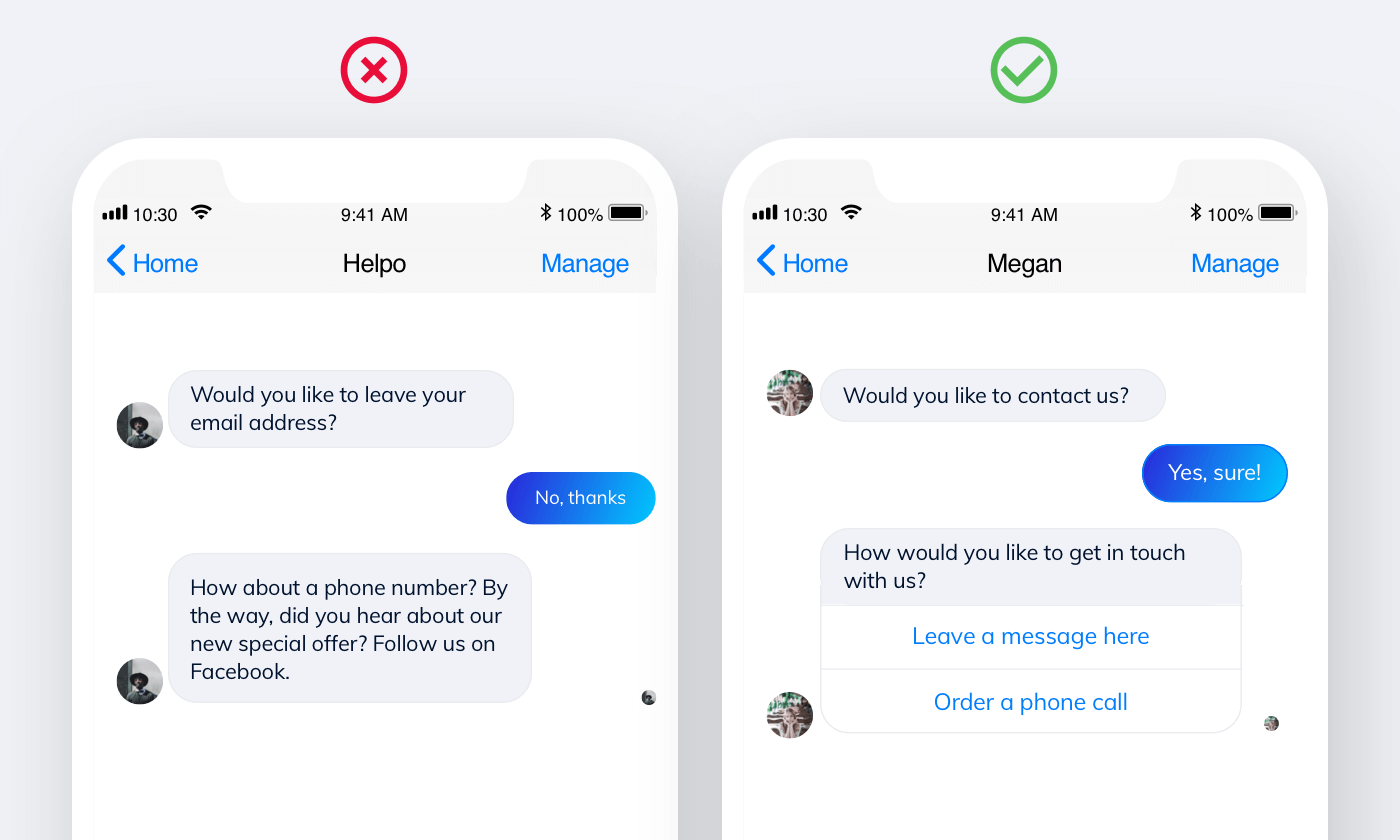
Chatbots can make product recommendations, offer discounts, or collect contact data. Still, don't make them do all of these things at once during a single conversation. State your goals clearly and think about how they can improve your customers' shopping experience – can they, for instance, quickly get information about new sales promotions? This can be something you can work with.
Choose the Voice That Matches Your Brand Personality
When you know what your goals and who your customers are, you can finally think about the things you want the chatbot to say. Make the users feel comfortable during the conversation. You can use everyday language and informal style or go for something more reassuring and professional. The voice should reflect the values that your business embodies.
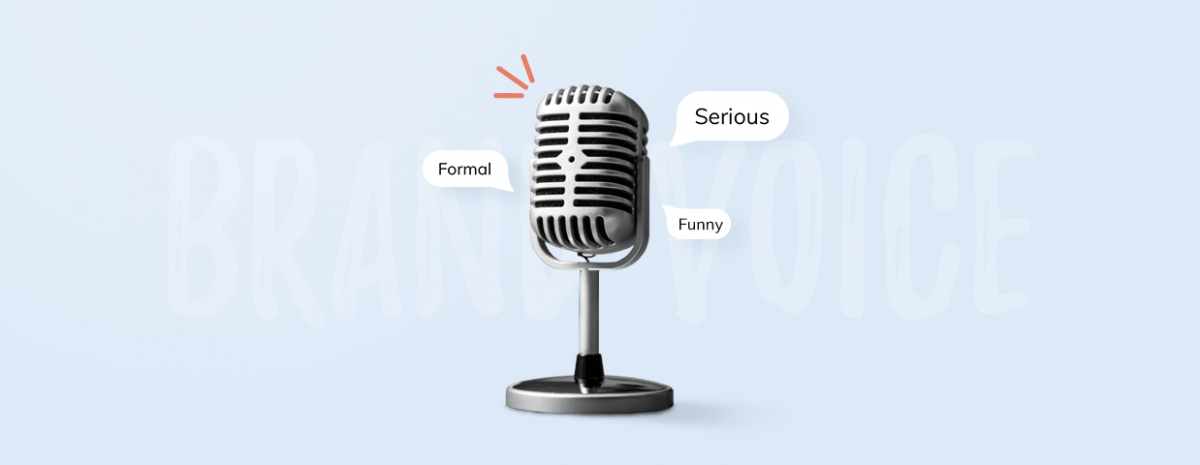
Your brand probably has a unique visual identity already: you've designed a company logo and your promotional materials are made in a specific visual style. You can do the same with your brand voice and add a chatbot to your brand book. The conversation design of your chatbots should be distinctive and linked with the character of your business.
Be careful! Chatbot messages are not similar to advertising texts. They are interactive, and users navigate through the conversation to complete specific tasks or find out about something. Remember, that in a way it is a part of your website interface and its primary function is to be easy to use. If a chatbot's "personality" draws too much attention, it may hamper user experience and become irritating.
Check out different chatbot examples and try to find the connection between the brand identity and the tone and language used by a chatbot.
Don't Overwhelm Users
Chatbot messages should be brief and to the point. It is tempting to provide detailed answers which exhaust the topic and satisfy even the most curious customers, but reading through blocks of writing is the very opposite of having a conversation.
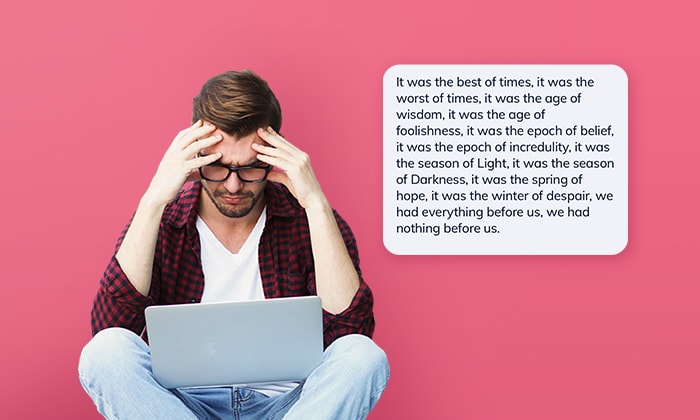
Chatbots can be immersive because their conversational mode of communication is based on taking turns, receiving new messages and progressing through dialogue. When all of a sudden the user hits against a wall of text, it halts the conversation by getting things out of balance. Imagine being served a football during a ping-pong match – the game is over.
Combine Different Types of Messages
Communication is a two-way process. You should take into consideration that conversations between a human and a machine can be difficult. If you decide to use NLP (Natural Language Processing) in your design, chatbots need to know what type of information they are receiving.
When people become self-conscious about the way they write and try to modify their natural language to make chatbots understand them, it can quickly get out of hand and turn into a disaster. Instead of being intuitive and transparent, the interface becomes an obstacle. Make it easier by providing hints and additional questions.
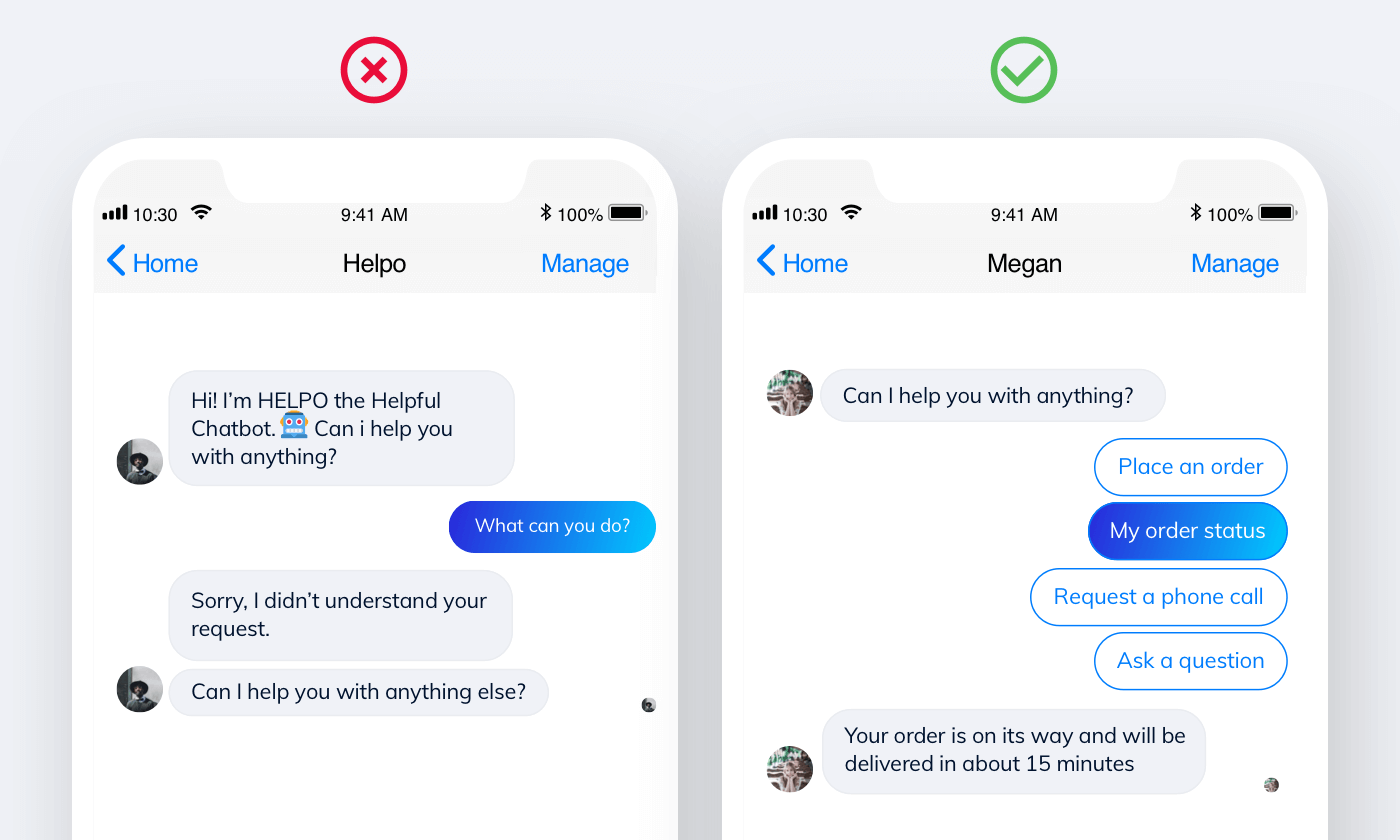
Use persuasive design techniques. Provide multiple-choice buttons and add Chatbot Cards. Everything you do should be user-oriented. Don't try to push your customers to write when it could be easier for them to choose one of the pre-defined answers suggested by a chatbot. As Erika Hall, the co-founder and Director of Strategy at Mule Design, notices:
It's a mistake to believe a conversational design means every user input and output has to be handled in a purely chat format. Whenever it makes sense, it's fine to consider a hybrid approach and use other interactive elements within the conversation.
Erika Hall
Author of Conversational Design | https://medium.com/@mulegirl
With a well designed conversational UI, it should be clear what happens when a particular quick reply is chosen. Users should be able to anticipate the results of their actions.
Use Non-Verbal Means to Make Chatbots More Human
You can humanize your chatbots by doing what people do when they chat via messaging apps. Add images, emoticons and animations to make up for the lack of gestures and face mimic. Bare text may appear dry and emotionless.

We are used to seeing GIFs and emojis when we send messages to each other – they are the emotional punctuation marks of the Internet. They can clarify the intent of a message and make it more vivid. Additionally, you can set delay periods between messages, which emulate the natural flow of a conversation with a human being. It makes your conversation design feel more organic.
Map out Possible Conversation Outcomes
Hitting a dead-end is one of the most common conversation design traps. When your customers don't know how to respond or what to do next, they may become frustrated. Or, even worse, they may think that it is their fault and that they are to blame for not being able to use your chatbot correctly. These negative feelings can discourage them from visiting your website again.
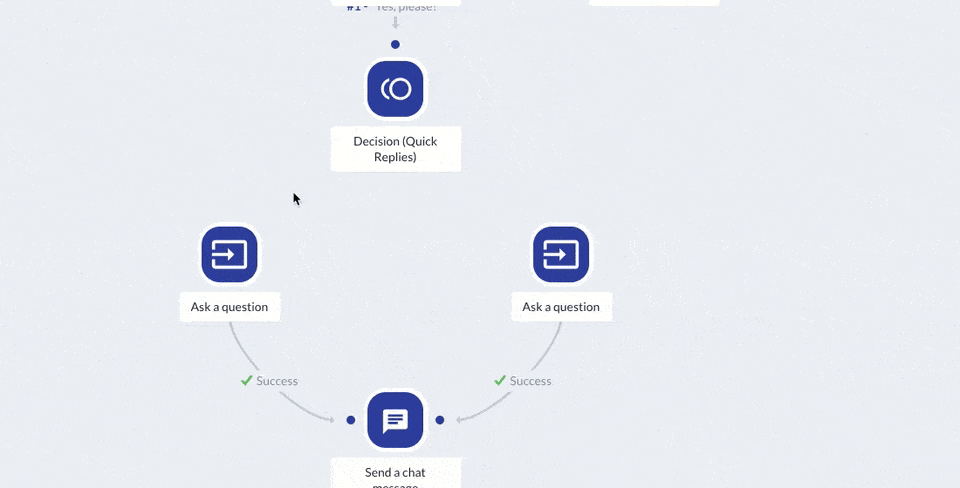
Design and test your conversation scenarios with Tidio's editor. It is great for prototyping your chatbots and bringing them to life with one click of a button. You can instantly try out your bots and avoid conversational stalemates.
Buildup and Payoff
Identify the critical moments within the conversation. If they require special attention – like submitting personal information or giving feedback – reward the customers for their patience. For instance, when they complete a purchase, your chatbot can send a "Congratulations!" message. Every conversation design should be a small story with a clear beginning and ending.
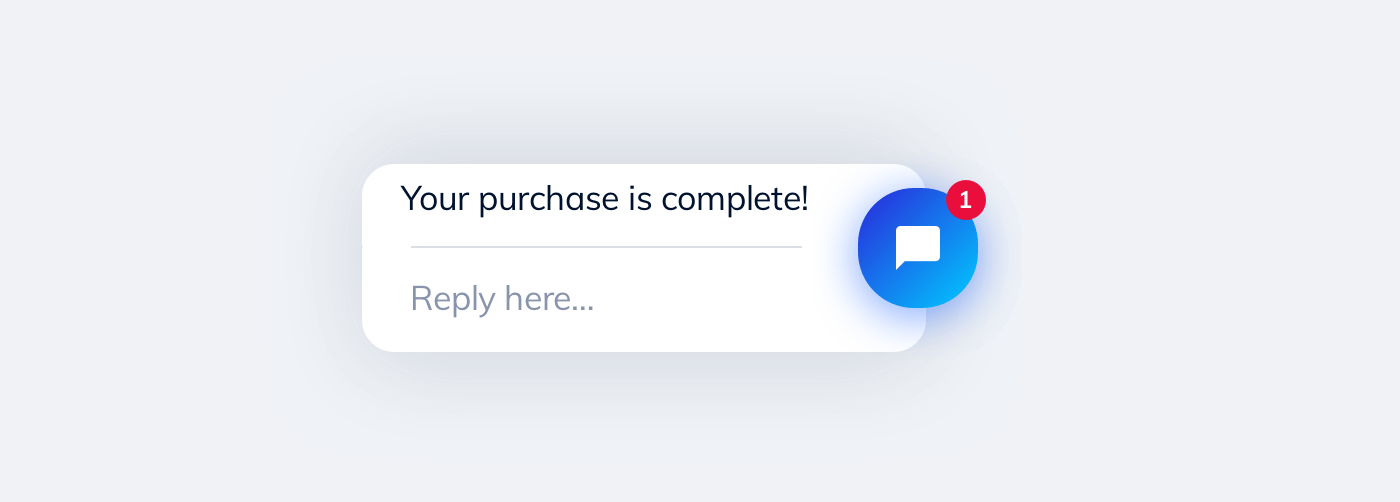
It may seem trivial, but it is an important signal that the customer completed the task correctly and everything is fine and in order. It conveys a sense of completeness and releases the tension which may have built up during shopping. After all, making money-related decisions can be difficult.
Fire up or Calm Down
Sometimes your customers may need a gentle push in the right direction. Your chatbot can entice them to act or reassure that performing a particular action won't have negative consequences. It is a good practice to notify them if they can take care of something later or go back if they change their mind. When designing your conversation flow, try to be encouraging and helpful, but don't patronize the customers.
People tend to identify with their conversation partners and they adjust attitude and emotions accordingly. That's why bloggers often use chatbots for WordPress to encourage reading and make visitors excited about the content. Keep the voice consistent, but modify the tone correspondingly. Always respect your customers' choices. Never make your conversation design manipulative or misleading.
Man + Machine = ♥
People are unpredictable, so they need guidance and subtle hints when using conversational UI. Chatbots can retrieve information in fractions of a second. They can simultaneously hold hundreds of conversations. They don't get tired, impatient or angry. But, they also don't get jokes. A good conversational design should enable people and virtual conversation agents to meet halfway on neutral ground.
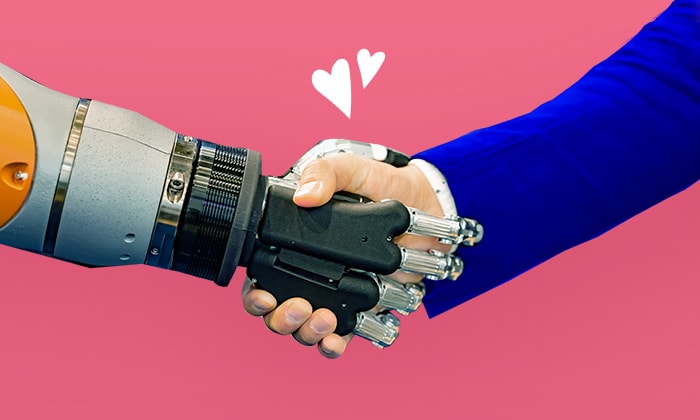
Remember that human beings and computers can complete each other. Make the most of the strengths, weaknesses, and limitations of both. Take into account characteristics such as the ability to improvise, empathy, flexibility, memory, or speed of data processing. Accept the differences and don't force customers or chatbots to do the things they are not good at.
Conversational Design – It's All About the Flow!
Conversational design is UX Design stripped down to its bare essentials. It is all about words and the order of messages exchanged between two agents – the user and the computer. The critical part to remember is that conversational design refers to the dynamics of this exchange, and not only individual messages as such.
Remember about the principles of designing chatbots when you use Tidio!
Provide 24/7 customer service even when you sleep.
Create unlimited chatbots for your website without coding to engage more visitors.
Learn About Chatbots
How To Create Ui For Chatbot
Source: https://www.tidio.com/blog/10-principles-of-conversational-ui-to-design-better-chatbots/
Posted by: cattplithenewark.blogspot.com

0 Response to "How To Create Ui For Chatbot"
Post a Comment